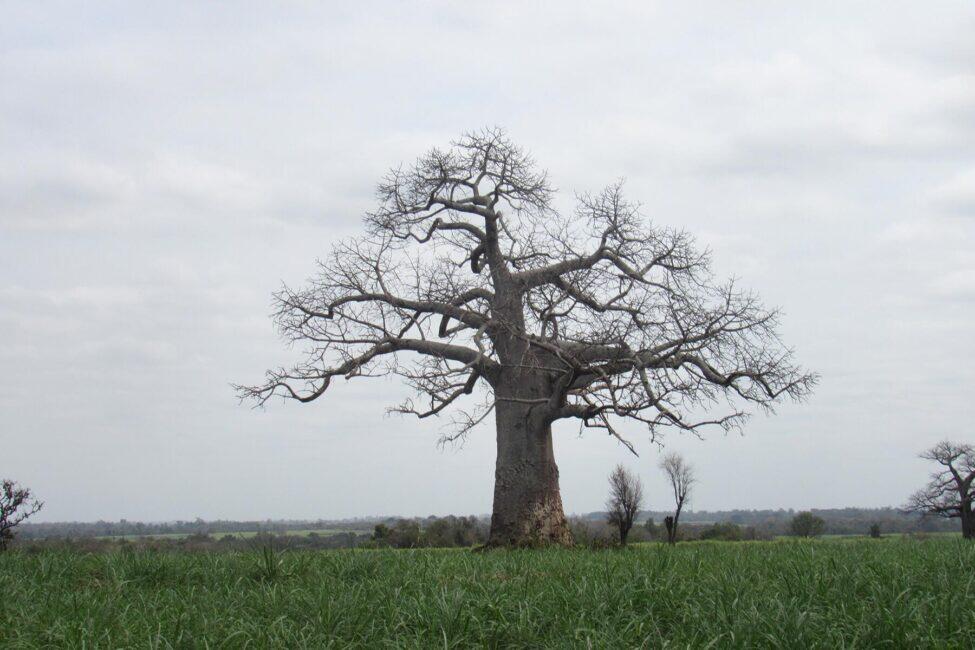In Zimbabwe, the small town of Chiredzi is home to a dizzying amount of Baobab trees.
In Chiredzi, hot weather and sugarcane farming are the hallmarks of this little town in the southeastern corner of Zimbabwe. Many travelers only know Chiredzi as a transit point on the way to the wildlife game reserves like Gonarezhou and Malilangwe. Many people envision Chiredzi as just a desolate and remote farming town. But in a way, Chiredzi’s isolation has nurtured one of Zimbabwe’s most thriving and extraordinary urban and peri-urban plant life: the Baobab Tree.
Chiredzi might be hot and dry, but surprisingly it has thickly vegetated surroundings and environs where diverse grasses, bushes, and trees thrive. Among the local trees, you will also spot the world-famous baobab trees. Baobab trees are among the biggest and longest-living trees in the world. In the warm regions of Zimbabwe, like Chiredzi, where they mostly thrive, baobab trees dwarf almost all other forms of vegetation.
Unlike in other places where you have to look around to spot these unique trees, in Chiredzi, baobabs are seemingly plentiful. Plus, baobab trees are part of the neighborhood skyline. Some households even have these giant trees right in their yards. Predictably, this irks these residents, given the cost of urban land and the ample space needed to accommodate a tree as big as a baobab.
Recommended Fodor’s Video
Nevertheless, the trees compensate people in their own way, says Paddy Mudhara, who leaves next to a baobab tree in Tsvovani Township. “With a baobab tree around, you have a lifetime guarantee of creamy fruits and a refreshing shade.”

Where to See Africa’s Unique Baobab Trees
In Africa, baobab trees are usually regarded as out-of-town trees, here you can see these giant and real-estate stealing trees even in the town center. Along Msasa Road, one of the town’s busiest streets, there are at least five big baobab trees on both sides. Even at Clever Hotel, Chiredzi’s main hotel, there are a couple of baobab trees in the hotel yard. With so many baobab trees around, sun-scorched street vendors use baobab trees as vending spots to shade them from the relentless afternoon sun.
Just a twenty-minute ascent to Chitsanga can reward you with beautiful baobabs and the sight of wild baboons quarreling over baobab fruits.
But nowhere in Chiredzi is the sheer number of baobab trees more astonishing than in Chitsanga, a small hill near Chiredzi Railway Station. Chitsanga Hill, which is also the best vantage point for a picturesque view of Chiredzi, has so many baobab trees that many people believe it has one of the highest concentrations of baobab trees in Zimbabwe. Just a twenty-minute ascent to Chitsanga can reward you with beautiful baobabs and the sight of wild baboons quarreling over baobab fruits.
If you are not surprised by the unusually high number of baobab trees in Chiredzi, the sizes of some of the trees will still amaze you. After all, here, photosynthesis is powered by a relentless sun that roasts the town for almost half the day. In Chiredzi, baobab trees grow as big as they want. Several baobab trees in Chiredzi are so big that a small van parked at one side of the tree can be invisible from the other side. Along the road to the Government High School, there is another baobab tree so big that the local municipality left it boldly standing right in the middle of this busy road.
And, a baobab tree growing in the middle of a field is a farmer’s worst nightmare. In a cane field, a baobab tree’s twenty-five-foot trunk and giant roots will rob the other crops of all the water and nutrients. However, due to the costs of cutting down these giant trees, many big baobab trees still stand defiantly in the middle of some cane fields. One of Zimbabwe’s biggest recorded baobab trees can be seen about a mile from The Vic Falls, another must-see Zimbabwe travel destination.

Size aside, a close look at some of the baobab trees in Chiredzi will always reveal something strange about the tree. In one open space near the town’s public hospital, a baobab tree leans sideways, just like the leaning Tower of Pisa. In a forest behind Tsvovani Stadium, two baobab trees grow so close to each other that they look like the baobab tree version of conjoined twins.
“There are many abnormal baobab trees scattered around Chiredzi,” explains Mamutse, a local firewood dealer who has explored most of the virgin jungles in the outskirts of the town. “To see them, you have to be patient and spare the time to observe each tree closely.”
The Surprising Role That Baobab Trees Serve
One of the most amazing baobab trees in Chiredzi is in a sugarcane field in Hippo Valley Estates near the Undumba Compound, about 25-minutes by road from Chiredzi. This baobab tree, which is lying right on the ground with its trunk, looks very lifeless. But come spring, the dead-looking tree transforms into a lively and fruit-bearing tree. At Undumba, locals like this particular baobab tree because, as one resident said, “you can easily climb up and pick the fruits, even if you are the worst tree climber in the world.”

In Africa, different fungal diseases sometimes damage baobab trees leaving them with hollow trunks. In rare cases, the hollow trunks can be big enough to accommodate people. Along a stream, at the edge of the Chiredzi industrial area, people use a baobab tree’s hollow trunk as a shelter from the rains and scorching sun. In some extreme cases in neighboring South Africa, some baobab trees have been hollowed out and house bars or restaurants.
Since baobab trees are some of the oldest living plants in the world, most of the baobab trees in the world are much older than the oldest living human beings. In Chiredzi, some of the trees have stories to tell about the town’s history. Pioneers of the town claim that the town’s “creamiest” baobab tree, which is near the Municipal office, used to be the meeting place of the town’s founding fathers back in the 1960s.
With so many baobab trees around, some residents of Chiredzi have personal connections with certain baobab trees in and around the town. Along the Chiredzi-Mkwasine railway line, many local faith healers, traditional healers, and witch doctors have their own personal’ baobab trees for shrines and healing ceremonies. Around town, a couple of self-employed cobblers, carpenters, and bicycle repairmen have personalized baobab trees for use as a private workshop.
Getting to Chiredzi
Chiredzi town might be off the tourist trail, but it is also accessible by air through Buffalo Range Airport. The town’s proximity to Gonerezhou Game Reserve and Malilangwe Conservancy makes it an important gateway or stopover for many travelers who frequent these famous game reserves. And if you are planning to visit these world-famous game reserves, it is high time you upgrade Chiredzi from stop-over status to destination status in order to revel in the majesty of the extraordinary baobab trees.




